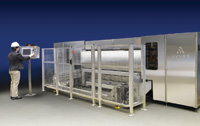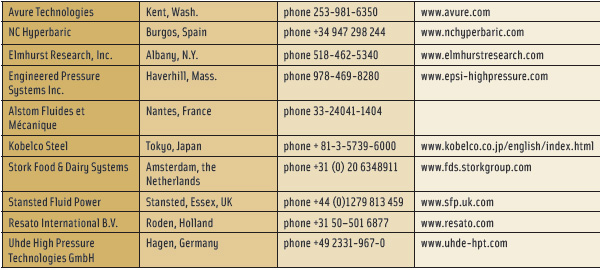High-Pressure Effects on Foods
PROCESSING
Nonthermal processing technologies include high-hydrostatic-pressure or high-pressure processing (HPP), pulsed electric fields (PEF), irradiation, and several others. The objective of most such processes is commercial sterilization or at least extended shelf life of foods. To date, there has been limited commercialization of most of these processes, although irradiation is fairly widely used. HPP has limited effect on spores and so has not been successful in preserving low-acid foods without refrigeration. PEF, discussed in previous columns, is commercially applied to fruit and vegetable juices by one producer. Of the nonthermal processes other than irradiation, HPP has had the widest application.

Effects of HPP
According to Dan Farkas, retired head of the Food Science Dept. at Oregon State University now consulting from Sausalito, Calif. (phone 415-332-5461), the following are some of the effects of HPP that have been noted:
• Protein Unfolding. High pressure can unfold proteins in a somewhat controlled manner as a function of pressure and temperature. Farkas says that there is a company, pressurebiosciences.com, that makes high-pressure equipment just to unfold proteins. Shucking of shellfish (oysters, lobster, crab, etc.) is a popular application of HPP in the range of 40,000 psi.
• Cell Wall Opening. Researchers have championed HPP, PEF, and ultrasonics for opening cells to promote quick release of useful secondary metabolites. A mundane example would be to increase the extraction of sugar from sugar beets.
• Setting of Starches. HPP will set starches without heat, yielding a raw starch gel.
• Pressure Freezing. This process can be used to produce very small ice crystals. Foods are cooled to –20ºC under pressure. Under a pressure of 27,000 psi, the water remains in liquid form because the high pressure counters the expansion of water when it tries to freeze during cooling. When the pressure is released, small ice crystals can form throughout the food mass to help freezing at atmospheric pressure. Also, foods can be thawed quickly using pressure thawing by reversing the process, i.e., applying high pressure to frozen foods and then warming. The phase transition from ice to liquid water is almost instantaneous.
• Diffusion. Attempts have been made to use HPP to promote rapid diffusion of water into beans and other foods for rapid hydration. Farkas doubts that this actually works well.
• Setting Large Wheels of Cheese. HPP can direct-set Cheddar cheese curd, ensuring uniform salt distribution and rapid processing.
• Pressure Blanching. Some plant and animal enzymes are unstable enough to be inactivated to a useful low level by high pressure. Avocado is the best example, in which browning is prevented by HPP. HPP has allowed the refrigerated distribution of thousands of tons of guacamole—this may be the largest single application of HPP so far.
• Enzyme Activation. Pressures in the range of 15,000 psi activate proteases and help tenderize meat prior to rigor.
Dairy Applications of HPP
Notably absent from the list of food products for which HPP has been commercialized are dairy products, according to Alan L. Kelly, Dean of Graduate Studies and Senior Lecturer in Food Technology, University College Cork (UCC), Ireland (phone +353 21 4903405), who performs research specifically on HPP effects on milk and other dairy products.
While HPP-processed meat, juice, fruit, and shellfish have all been launched around the world in recent years, Kelly said, dairy products have not been among those commodities. This is not because HPP has no interesting or relevant effects on milk or dairy products; indeed, the opposite is the case, he said—the effects of HPP on milk on dairy systems are complex, unique, and perhaps quite technologically significant. The argument may be made that it is precisely the complexity of the effects of HPP on milk which has hindered the commercial application, as scientists and technologists grapple with the findings of research in this area.
A reflection of the state of dairy HPP research, according to Kelly, is the fact that far more papers have appeared in the scientific literature on the effects of HPP on milk and milk products than on almost any other commodity group.
One of the more interesting phenomena is the selectivity of HPP inactivation. Often, HPP will kill or inactivate spoilage and pathogenic organisms without seriously affecting probiotic or desirable cultures in products such as yogurt and other "healthy" dairy-based products, valued for their live cultures.
Kelly said that HPP causes microbial inactivation in milk and many other food products, but that spores remain a problem for low-temperature inactivation. It seems unlikely that HPP will become economically attractive as a milk preservation technology, he said, compared to well-established processes such as pasteurization and ultra-high-temperature (UHT) treatment for extended-shelf-life milk.
Dietrich Knorr, Professor of Food Science, and his colleagues at the Technical University of Berlin (phone +49 30 31471250) have investigated the effects of HPP on spores and vegetative cells. An important factor in the inactivation of spores is their state of aggregation, which the group measures optically. When this factor is incorporated into a model, the researchers can accurately correlate their data. Still, it is difficult to get an adequate reduction in spores in low-acid foods using HPP alone. Pressure-assisted heating, however, shows some promise, according to some of the papers published by this group.
HPP may have interesting applications for dairy products where heat treatment would be undesirable or infeasible (in common with many other products where HPP has found a unique niche, such as guacomole), according to Kelly. For example, it may be possible to extend the shelf life of products such as yogurt (as Fonterra, a large New Zealand dairy cooperative, has proposed) or even quick-ripening cheeses (such as mold-ripened cheeses) by inactivation of microorganisms and enzymes, thereby arresting the metabolic reactions in the product which would otherwise result in progressive deterioration of quality. Kelly is currently examining the feasibility of such processes for blue and Camembert cheeses.
The concept of shelf life extension has been the first area where HPP dairy products have been commercialized, Kelly said. A soft cheese spread treated by HPP to inactivate microorganisms was recently launched in Spain, while Fonterra in New Zealand has proposed use of HPP for preservation of probiotic yogurt and biologically active colostrum, which would lose their health-enhancing characteristics if heat-treated.
In addition, a research collaboration between UCC and Agri-Food and Biosciences Institute, Belfast (under the direction of Margaret Patterson) is examining the potential for making raw-milk soft cheese using HPP to ensure that Listeria are inactivated. Early commercial results also suggested that HPP could greatly accelerate the ripening of cheese. More-recent studies have shown that the magnitude of such effects in most cases is quite modest; but great effects on the functionality (e.g., melting and stretching properties) of Mozzarella cheese after HPP of the freshly made cheese have been reported by researchers at UCC and Moorepark Food Research Centre in Moorepark, Ireland (Tom Beresford and Tim Guinee) The process greatly accelerated the development of desirable properties for use in pizzas, according to Kelly.
 Another major area of potential interest involves treating milk with HPP and using it as a base for making dairy products, because of the many unique effects of pressure on milk constituents. For example, Kelly said, HPP denatures whey proteins (as does heating) but, unlike any other process, it also affects the structure and properties of the casein micelles, resulting in either aggregation or disintegration of micelles, depending on the pressure, temperature, and pH. These changes, Kelly said, have great implications for the production of dairy products from such milk, e.g., altering the rennet coagulation properties of milk and perhaps the texture and ripening of cheese. UCC researchers are studying the effects of HPP on cheese-making properties of milk for use in Cheddar cheese production. In addition, HPP also seems to have significant effects on acid coagulation properties of milk and if applied to ice cream mixes to have substantial effects on the final product characteristics.
Another major area of potential interest involves treating milk with HPP and using it as a base for making dairy products, because of the many unique effects of pressure on milk constituents. For example, Kelly said, HPP denatures whey proteins (as does heating) but, unlike any other process, it also affects the structure and properties of the casein micelles, resulting in either aggregation or disintegration of micelles, depending on the pressure, temperature, and pH. These changes, Kelly said, have great implications for the production of dairy products from such milk, e.g., altering the rennet coagulation properties of milk and perhaps the texture and ripening of cheese. UCC researchers are studying the effects of HPP on cheese-making properties of milk for use in Cheddar cheese production. In addition, HPP also seems to have significant effects on acid coagulation properties of milk and if applied to ice cream mixes to have substantial effects on the final product characteristics.
Kelly concluded that the research on HPP of dairy systems illustrates the exciting effects of this new technology on milk and its products, and the industrial world is now beginning to exploit these findings to produce the next generation of dairy products.
Effects of Another Nonthermal Process, MEF
In the course of research on the mechanisms underlying other nonthermal processes, other effects on foods have been noted. In some cases, these can have interesting applications.
For example, according to Sudhir Sastry, Professor of Food Science at Ohio State University, Columbus (phone 614-292-3508), moderate alternating electric fields (MEF), even at field strengths three orders of magnitude lower than the 35,000–50,000 V/cm needed for pasteurization, can make fruit and vegetable cells more permeable, leading to higher yields of juice extraction.
Application of MEF to fermentation broths can reduce the lag phase of a growth curve and stimulate production of bacteriosins. Sastry attributes some of these effects to the range of frequencies or harmonics that naturally occur with most electric power supplies.
Sastry also commented that the power supplies needed to provide a relatively low-strength field (~10 V/cm) at frequencies associated with conventional electric power supplies are less expensive than the power supplies needed to generate a high-strength square wave, as is normally used in pulsed electric field processing. Thus, the equipment needed to realize some of the benefits of applying MEF to foods can be modest in cost.
by J. Peter Clark,
Contributing Editor,
Consultant to the Process Industries, Oak Park, Ill.
[email protected]
